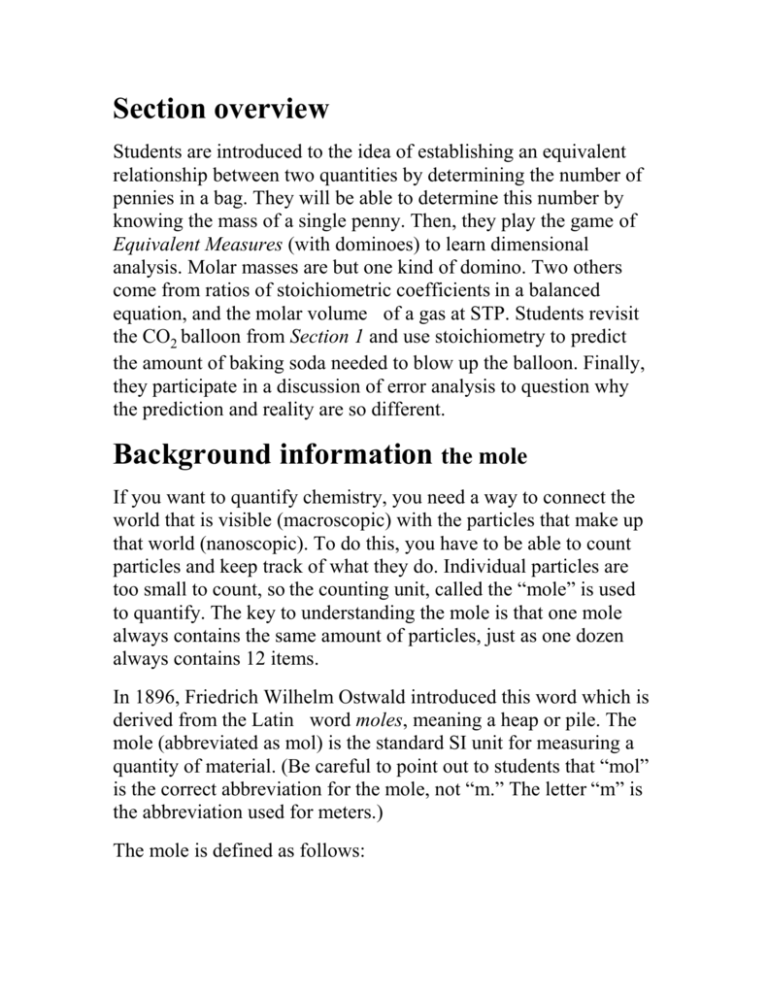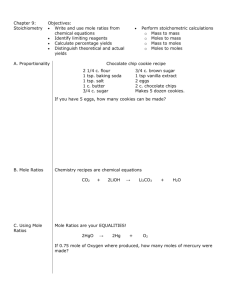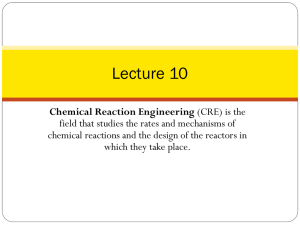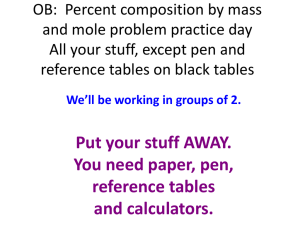moles of that material
advertisement

Section overview Students are introduced to the idea of establishing an equivalent relationship between two quantities by determining the number of pennies in a bag. They will be able to determine this number by knowing the mass of a single penny. Then, they play the game of Equivalent Measures (with dominoes) to learn dimensional analysis. Molar masses are but one kind of domino. Two others come from ratios of stoichiometric coefficients in a balanced equation, and the molar volume of a gas at STP. Students revisit the CO2 balloon from Section 1 and use stoichiometry to predict the amount of baking soda needed to blow up the balloon. Finally, they participate in a discussion of error analysis to question why the prediction and reality are so different. Background information the mole If you want to quantify chemistry, you need a way to connect the world that is visible (macroscopic) with the particles that make up that world (nanoscopic). To do this, you have to be able to count particles and keep track of what they do. Individual particles are too small to count, so the counting unit, called the “mole” is used to quantify. The key to understanding the mole is that one mole always contains the same amount of particles, just as one dozen always contains 12 items. In 1896, Friedrich Wilhelm Ostwald introduced this word which is derived from the Latin word moles, meaning a heap or pile. The mole (abbreviated as mol) is the standard SI unit for measuring a quantity of material. (Be careful to point out to students that “mol” is the correct abbreviation for the mole, not “m.” The letter “m” is the abbreviation used for meters.) The mole is defined as follows: So, how many particles is that? Many scientists have carried out experiments to determine exactly how many particles are in a mole. The best data available now are: This value is known as Avogadro’s number, to honor an Italian lawyer and physicist who originally had the idea, although he never determined the number. Conversions and Dimensional analysis Dimensional analysis is the process of converting quantities from one unit of measurement to another, using ratios that are equivalent. For example, a quantity of matter can be measured either as mass (in grams, kilograms, etc.) or moles. In the laboratory, you can only measure mass using a scale or balance. Therefore, a conversion from mass to moles is necessary. There are three kinds of dimensional analysis conversions presented in this section: 1) Mass of a material moles of that material 2) Moles of one material moles of another material 3) Moles of a gas volume of that gas, under known conditions of temperature and pressure Often, conversions are done in a continuous series to arrive at the desired answer. Conversion 1: mass of a material moles of that material If you know the identity of the material, you can convert between the mass and the moles by using an equivalent measure called molar mass (which is the mass of one mole of a material). The molar mass is expressed in grams per mole (g/mol). For example, one mole of sodium (Na) atoms has a mass of 22.99 grams. The molar mass of Na is 22.99 g/mol. This number can be obtained from the atomic mass listed on the periodic table. This conversion is used when changing between moles of sodium and mass of sodium. Two moles of sodium have a mass of 45.98 g. The conversion can be shown using dimensional analysis as follows: The fraction shown is the conversion factor, which in this case is the molar mass, g/mol. The numerator and denominator of this conversion factor are equivalent, except they are expressed in different units. In other words, one mole of Na atoms always has a mass of 22.99 grams. The conversion factor is the “domino” students are taught to use in this section to make this conversion work. The trick to the “dominoes” game is that the denominator unit must cancel the numerator unit in the previous domino. So, the moles of Na cancel each other out in this case, leaving grams of Na as the units in the answer. In the language of the dominoes game, this conversion looks like: To run the conversion backwards, the opposite domino would be used. For example, if you want to know how many moles of Na are in 45.98 grams of Na, the calculation would be: The molar masses of materials that are not simple elements can be calculated if you know how many of each type of particle are inside a unit of the material. Examples of this are presented in Step 9 of the Investigate section in the Student Edition. For example, one mole of water (H2O) has a mass of 18.02 grams, as shown in the Student Edition. Therefore, the mass of 2.000 moles of water is calculated this way. Conversion 2: moles of one material moles of another material When you have the quantity of a material expressed in terms of particles, you can use balanced chemical equations to keep track of what particles do. In this way, you can convert between particles of one material and particles of another material. The conversion factor used relates the quantity of particles of one type of material to the quantity of particles of another type of material. The balanced chemical equation 2H2O2 2H2O shows the relations between how many units of each kind of chemical are needed or produced. This is determined by the coefficients in the balanced equation and in this equation it takes 2 moles of H2 and 1 mole of O2 to make 2 moles of water (H2O). If you start with 4 moles of H2, then 2 moles of O2 are needed to react with all the H2. Or, it could be asked as a question: If you begin with 4 moles of H2, how many moles of O2 are needed so that all the H can react? The domino, using equivalent measures derived from the coefficients in front of the chemicals in the balanced reaction, is shown here: While this calculation using whole numbers is easy for students to do in their heads, more complicated numbers require the rigor of calculations. Conversion 3: moles of a gas volume of that gas Most matter is measured in the laboratory in mass. However, quantities of gases are often easier to measure by volume. So, it is convenient to know how to convert between moles of a gas and the volume of that gas. Since the volume of any gas under standard laboratory conditions (standard pressure of 1 atmosphere, temperature of 0oC) is the same (assuming ideal behavior), there is one conversion factor that works for all gases under these conditions. One mole of a gas takes up 22.4 liters of space at standard conditions (STP). As with any other conversion factor, it can be used in either direction. Using more than one conversion in a calculation More than one conversion can be used to do a calculation. The idea is that anything that appears in the denominator of one fraction can cancel something that appears in the numerator of another fraction. The trick to the calculation is to get the conversions placed so that everything cancels except the units you want in the end. This is the only rule in the dominoes game, and one which students are asked to figure out early in the section. The goal of this section is not to teach students to be able to do all stoichiometry calculations (that would take more time than is allotted for this section). The goal is to give students the tools they need to predict how many grams of baking soda are needed to inflate a balloon with enough CO2 gas to tip a lever by a specified amount. Therefore, if beginning with liters of CO2 gas, and ending with grams of baking soda (NaHCO3), the initial setup looks like this: (some amount) L CO2 gas (some conversion factors) = (some amount) g NaHCO3 This means that in the first conversion factor or domino, L CO2 gas must be in the denominator. And in the last domino, g NaHCO3 must be in the numerator. Since the only conversion you know that involves liters of gas is the third kind, then the first conversion factor must be: The only conversion you know that involves grams of a material is the first kind, so the last conversion factor must be: The missing domino in the middle (?) must then convert between moles of CO2 gas and moles of NaHCO3. For this, you must consider the balanced equation: NaHCO3 HC2H3O2 NaC2H3O2 H2O CO2 This shows that 1 mole of NaHCO3 yields 1 mole of CO2. The final setup then is: Stoichiometry The word “stoichiometry” derives from two Greek words: stoicheion, meaning “element” and metron, meaning “measure.” Doing stoichiometry calculations in chemistry involves mathematically relating the amount of one chemical to the amount of another. The most common kind of stoichiometry calculation asks what quantity of one chemical can be produced if a specified quantity of another chemical is used. It is sometimes helpful to students to map stoichiometry calculations. Examples 1A and 1C fit the same general map, although the chemical (Na) and conversion factor (domino) shown are specific to Example 1A only: The map for the stoichiometric calculation to determine the mass of baking soda required to inflate a balloon with CO2 gas to a desired volume is:







